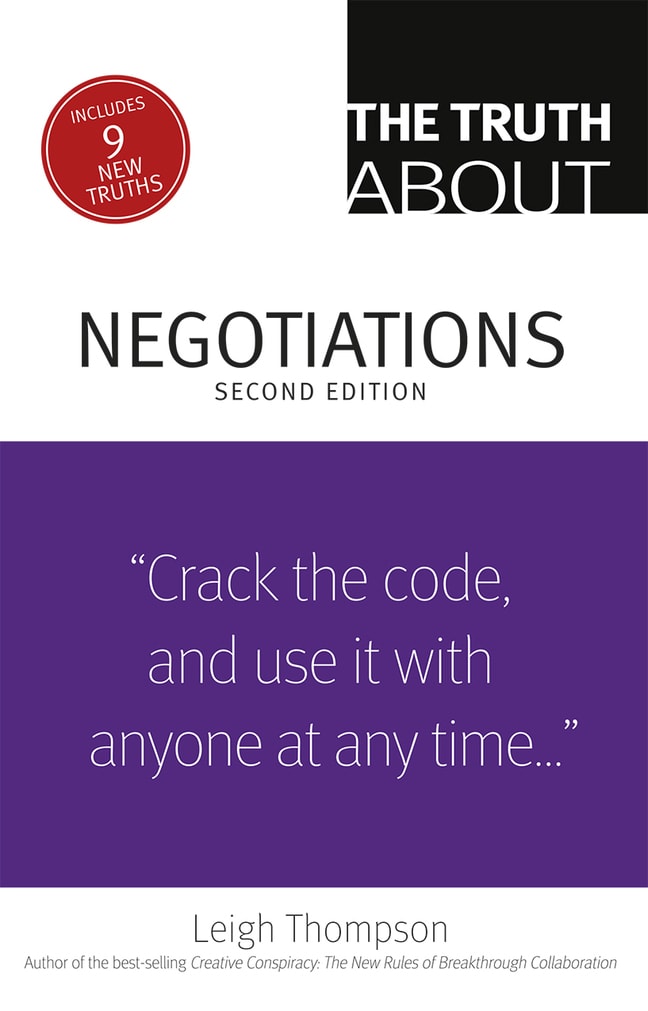
Truth About Negotiations, The, 2nd edition
Your access includes:
- Search, highlight, notes, and more
- Easily create flashcards
- Use the app for access anywhere
- 14-day refund guarantee
$10.99per month
Minimum 4-month term, pay monthly or pay $43.96 upfront
Learn more, spend less
-
Listen on the go
Learn how you like with full eTextbook audio
-
Find it fast
Quickly navigate your eTextbook with search
-
Stay organized
Access all your eTextbooks in one place
-
Easily continue access
Keep learning with auto-renew
Overview
Introduction vii
Part 1: Negotiation: A 30,000-foot view 1
Truth 1: Negotiation: A natural gift? 3
Truth 2: The magic bullet: Preparation 7
Truth 3: Your industry is unique (and other myths) 11
Truth 4: Win–win, win–lose, and lose–lose negotiations 15
Truth 5: Four sand traps in the golf game of negotiation 19
Truth 6: If you have only one hour to prepare 23
Part 2: The bottom line on bottom lines 27
Truth 7: Identify your BATNA 29
Truth 8: Develop your reservation price 33
Truth 9: It’s alive! Constantly improve your BATNA 37
Truth 10: Don’t reveal your BATNA 41
Truth 11: Don’t lie about your BATNA 45
Truth 12: Signal your BATNA 49
Truth 13: Research the other party’s BATNA 53
Part 3: Black belt negotiation skills 55
Truth 14: Set optimistic but realistic aspirations 57
Truth 15: The power of making the fi rst off er 61
Truth 16: What if the other party makes the fi rst off er? 65
Truth 17: Plan your concessions 69
Truth 18: Be aware of the “even-split” ploy 73
Truth 19: Reveal your interests 77
Truth 20: Negotiate issues simultaneously, not sequentially 81
Truth 21: Logrolling (I scratch your back, you scratch mine) 85
Truth 22: Make multiple off ers of equivalent value simultaneously 89
Truth 23: Postsettlement settlements 93
Truth 24: Contingent agreements 97
Part 4: Psychology 101
Truth 25: The reciprocity principle 103
Truth 26: The reinforcement principle 107
Truth 27: The similarity principle 111
Truth 28: The anchoring principle 115
Truth 29: The framing principle 119
Part 5: People problems (and solutions) 123
Truth 30: Responding to temper tantrums 125
Truth 31: How to negotiate with someone you hate 129
Truth 32: How to negotiate with someone you love 133
Truth 33: Of men, women, and pie-slicing 137
Truth 34: Your reputation 141
Truth 35: Building trust 145
Truth 36: Repairing broken trust 149
Truth 37: Saving face 153
Part 6: I-negotiations and E-negotiations 157
Truth 38: Negotiating on the phone 159
Truth 39: Negotiating via email and the Internet 163
Truth 40: When negotiations shift from relational to highly transactional 167
Truth 41: Negotiating across generations 171
Truth 42: Negotiating with diff erent organizational cultures 175
Truth 43: Negotiating with diff erent demographic cultures 179
Part 7: Negotiation Yoga 183
Truth 44: What’s your sign? (Know your disputing style) 185
Truth 45: Satisfi cing versus optimizing 189
Truth 46: Are you an enlightened negotiator? 193
References 197
Acknowledgments 203
About the Author 204
Published by Financial Times/ Prentice Hall (June 22nd 2021) - Copyright © 2014
ISBN-13: 9780137460472
Subject: Business Communication
Category: Truth About Negotiations, The
Your questions answered
When you purchase an eTextbook subscription, it will last 4 months. You can renew your subscription by selecting Extend subscription on the Manage subscription page in My account before your initial term ends.
If you extend your subscription, we'll automatically charge you every month. If you made a one‑time payment for your initial 4‑month term, you'll now pay monthly. To make sure your learning is uninterrupted, please check your card details.
To avoid the next payment charge, select Cancel subscription on the Manage subscription page in My account before the renewal date. You can subscribe again in the future by purchasing another eTextbook subscription.
When you purchase a Channels subscription it will last 1 month, 3 months or 12 months, depending on the plan you chose. Your subscription will automatically renew at the end of your term unless you cancel it.
We use your credit card to renew your subscription automatically. To make sure your learning is uninterrupted, please check your card details.